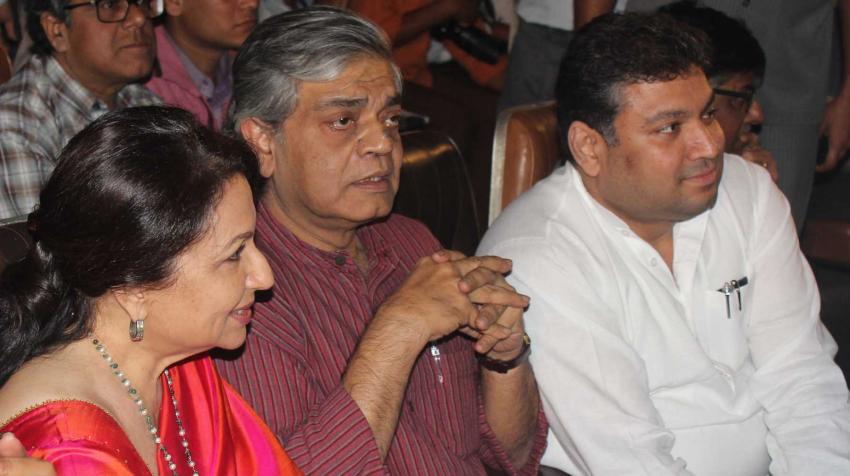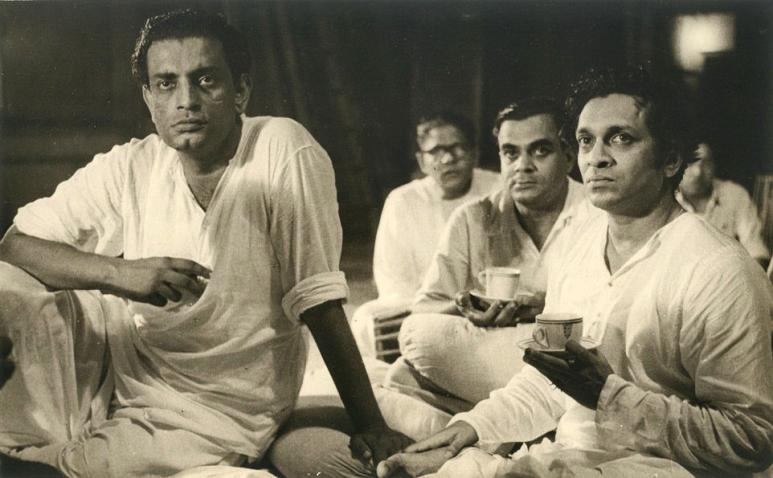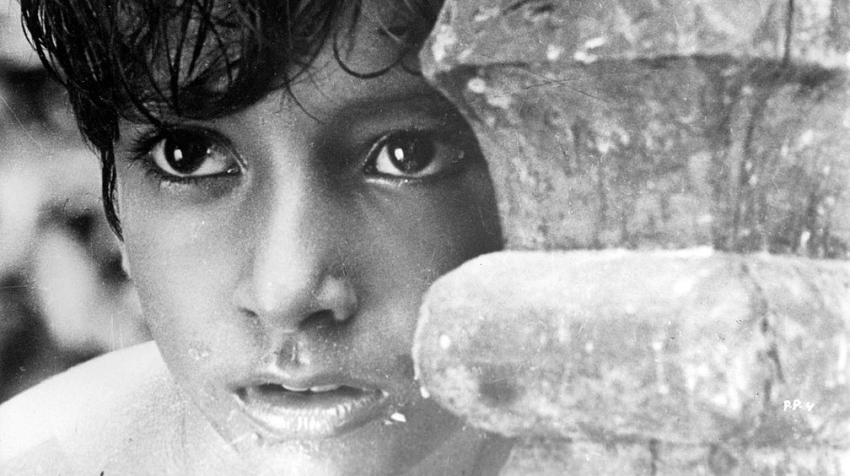UDAYAN PANDIT: You first tell me if you are on my side or not...
BAGHA BYNE: We are on the side of good.
GOOPY GYNE: Yes, on the side of good.
This swift exchange between the schoolteacher-turned-rebel Udayan Pandit and the protagonists Goopy and Bagha in the film Hirak Rajar Deshe (Kingdom of Diamonds, 1980) sums up the universal humanism that permeated Satyajit Ray’s films. Simple yet profound.
This “children’s film for everyone” is a landmark work of art dealing with resistance against tyranny, with a people’s uprising against totalitarianism. Forty years later, Hirak Rajar Deshe—the tale of a teacher and his unlikely allies, Goopy the singer and Bagha the drummer, toppling a tyrant—rings truer than ever, as leaders around the world display streaks of the anti-democratic Hirak Raja, out to suppress any form of dissent or critique.
Hirak Rajar Deshe ends on a note of idealistic hope and popular rejoicing as the despot is subjected to his own magajdholai (brainwashing) machine, his giant statue is pulled down by the people, and freedom and justice are restored to the land.
The endings of Ray’s films often symbolize the humanism and hope that he came to typify as a unique creative force between 1955 and 1992.
Take Ganashatru, his 1989 film based on Henrik Ibsen’s An Enemy of the People, but transcreated in a Bengali small-town setting. Ibsen’s play ends on a brutal individualistic note— “the strongest man in the world is he who stands most alone”. Ray’s film, however, ends with the upright, idealistic doctor hounded by his community for standing up for science and truth, asking “There is hope?”, and on cue the sounds of a rally in his support organized by a young and educated group of locals can be heard. Overwhelmed, the doctor exults, “I am not alone!”
Individual struggle for the collective good was often a Ray leitmotif. As he once put it, “I too am an activist—as an artist. That’s my way.” 1
That way of art as activism, of art as an agent of change, was recognized and celebrated by the United Nations some 23 years after Ray’s passing, with the exhibition “The Transformative Power of Art”. His portrait was unveiled in New York in 2015 along with those of 15 other creators, including the likes of Audrey Hepburn, Joan Baez and Malala Yousafzai, to “bring out humanity’s transformative power… as … art can indeed transform lives”.
That Ray found pride of place in this pantheon was no surprise because his films did indeed mirror the United Nations core values of universal human rights, justice and dignity for all people, and equity. And they did so by telling human stories and by focusing on relationships and emotions.
Sharmila Tagore, the heroine of Apur Sansar (The World of Apu, 1959), put it succinctly: “For Tagore and Ray, the people and their predicament came first.” 2 She was, of course, referring to the most towering cultural icon of Bengal, Rabindranath Tagore, the Nobel Laureate polymath who had a deep influence on Ray.
“I have been moved by Tagore's work ... Of course, our cultural background, our cultural makeup, is a fusion of East and West.... We have imbibed Western education, Western music, Western art, Western literature,” Ray said. 3

Ray’s creative sensibility was a combination of nature and nurture. His grandfather, Upendrakishore Ray, was a famous Bengali writer, illustrator, philosopher and prominent figure of the Brahmo Samaj (an offshoot of Hinduism that shunned idol worship and emphasized the equality of man). His father, Sukumar Ray, was a pioneering Bengali writer of nonsense rhyme and children’s literature as well as an illustrator and a critic. His inspirations ranged from Rabindranath Tagore to his teachers Nandalal Bose and Benode Behari Mukherjee in Santiniketan, from the films of Renoir and De Sica (Bicycle Thieves), Chaplin and Ford (Fort Apache) to the photography of Cartier Bresson and the music of Beethoven.
So, when his biographer, Andrew Robinson, was to ask him if he considered himself “50 per cent Western”, Ray had replied: “Yes, I think so—which makes me more accessible to a Western audience than someone who’s not to the same extent influenced by Western models.” 4
And yet, Ray remained loyal to his roots and the dishevelled study in his south Calcutta (now Kolkata) home was forever his creative headquarters, from where he explored and depicted universal human values through his films. He was a truly “glocal” citizen—steadfastly local in his medium of work but effortlessly global in its appeal.
Take one of my favourite sequences in a Ray film, the charming memory game in Aranyer Din Ratri (Days and Nights in the Forest, 1970), where the central characters rattle off names of famous personalities. The glocal range of characters thrown up by the game never ceases to amaze me, as I put my Ray memory to the test—“Rabindranath, Karl Marx, Cleopatra, Atulya Ghosh, Helen of Troy, Shakespeare, Mao Tse Tung, Don Bradman, Rani Rashmoni, Bobby Kennedy, Tekchand Thakur, Napoleon, Mumtaz Mahal”!
It was significant that the memory game focused only on people. As Ray was to say: “I am not conscious of being a humanist. It’s simply that I am interested in human beings.”5 And the manner in which he depicted human beings, their frailties and their struggles, their individual rebellions and simple triumphs, drew admirers far and wide.
It is no wonder that when Ray approached Richard Attenborough hesitantly for a small role in Shatranj Ke Khiladi (The Chess Players, 1977), the British thespian said: “Satyajit, I would be happy to recite even the telephone directory for you.”6 After having worked with Ray, Attenborough was to liken his genius to that of Chaplin.
So fundamental to life and humanity were Ray’s creations that the Japanese director Akira Kurosawa once wrote: “Not to have seen the cinema of Ray means existing in the world without seeing the sun or the moon.”7
Even before he had embarked on his first film, Pather Panchali (1955), Ray had written a piece titled “What Is Wrong with Indian Films?” in The Statesman newspaper in Calcutta in 1948—“The raw material of the cinema is life itself. It is incredible that a country which has inspired so much painting and music and poetry should fail to move the filmmaker. He has only to keep his eyes open, and his ears. Let him do so.”

Ray did just that over the next 40 years and 37 films. From human dignity amid tragedy in The Apu Trilogy to the resilience of the human spirit in Mahanagar; the strong anti-war message through a children’s fable in Goopy Gyne Bagha Byne to the triumph of punishment over crime in his popular detective films Sonar Kella and Joi Baba Felunath.
Ray’s final film, Agantuk (The Stranger, 1992), was a culmination of the master storyteller’s philosophy and belief systems. When casting Utpal Dutt for the central role of The Stranger, Ray told the veteran actor that he had put his own views into this character and so he must speak on the filmmaker’s behalf. From civilization to religion, Tagore to tribal peoples, science to morality, social duties to human values—Ray the humanist explored them all in a most personal manner.
Legend has it that on the final day of shooting his last film, Ray threw his hands up in the air and said, “That’s it. That’s all there is. I don’t have anything more to say.” Not long after, he passed away in his beloved Calcutta.
Less than a month before his passing, Ray received an Honorary Oscar. The Academy Award citation read: “To Satyajit Ray, in recognition of his rare mastery of the art of motion pictures, and of his profound humanitarian outlook, which has had an indelible influence on filmmakers and audiences throughout the world.”
Notes
1 Derek Malcolm, "Satyajit Ray: Interview", in Satyajit Ray: Interviews, Burt Cardullo, ed. (Jackson, Mississippi, University Press of Mississippi, 2007).
2 Shamila Tagore, "What Satyajit Ray Left Us is an Inheritance of Endless Possibilities", The Wire, 11 September 2015. Available at https://thewire.in/film/what-satyajit-ray-left-us-is-an-inheritance-of-endless-possibilities
3 Udayan Gupta, "The Politics of Humanism: An Interview with Satyajit Ray", in Satyajit Ray: Interviews, Burt Cardullo, ed. (Jackson, Mississippi, University Press of Mississippi, 2007).
4 Andrew Robinson, Satyajit Ray: The Inner Eye: The Biography of a Master Film-Maker (New York: I.B. Tauris, 2004).
5 Andrew Robinson, "Satyajit Ray: A Moral Attitude", Sight and Sound , 20 May 2020. Available at: https://www2.bfi.org.uk/news-opinion/sight-sound-magazine/features/satyajit-ray-moral-attitude
6 Suresh Jindal, My Adventures with Satyajit Ray: The Making of Shatranj Ke Khilari (Noida, India, HarperCollins, 2017).
7 Andrew Robinson, Sudden Genius? The Gradual Path to Creative Breakthroughs (New York, Oxford University Press, 2010).
The UN Chronicle is not an official record. It is privileged to host senior United Nations officials as well as distinguished contributors from outside the United Nations system whose views are not necessarily those of the United Nations. Similarly, the boundaries and names shown, and the designations used, in maps or articles do not necessarily imply endorsement or acceptance by the United Nations.




